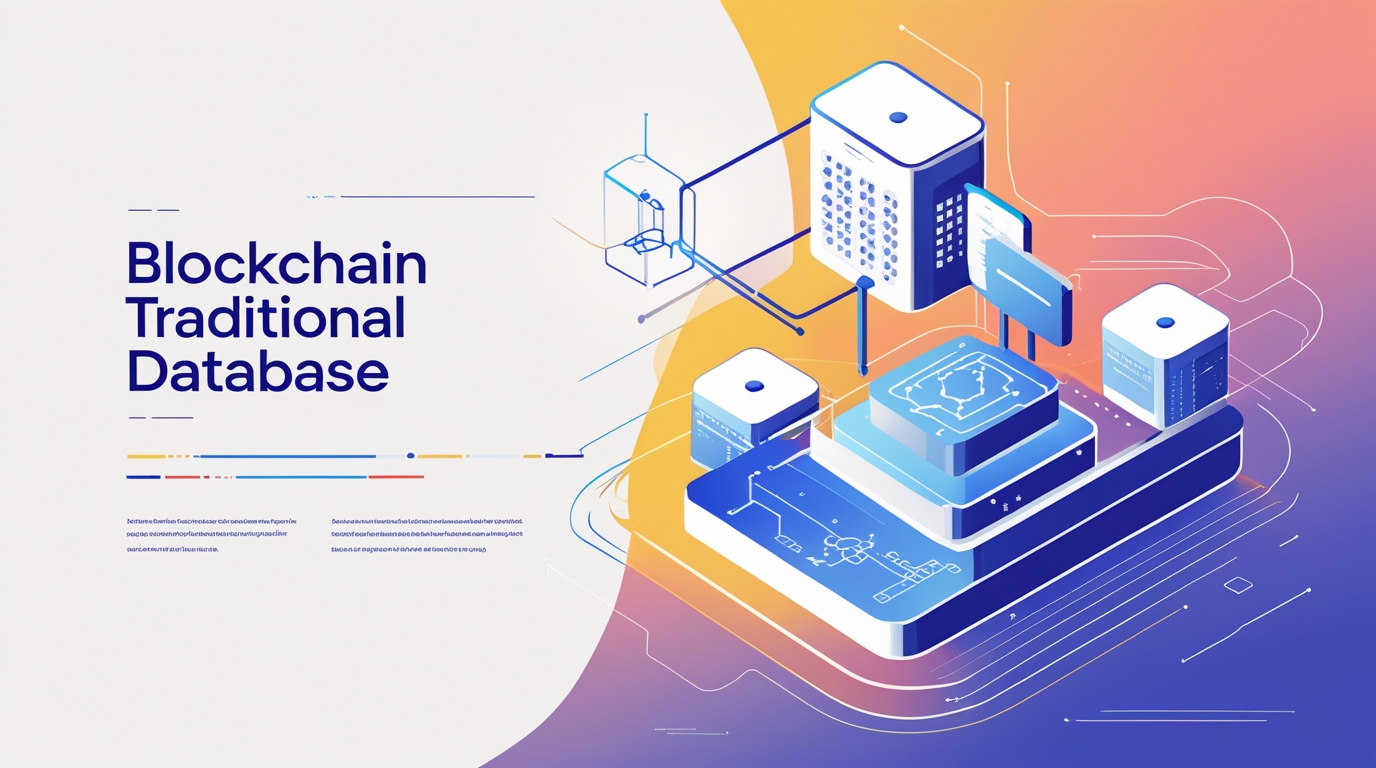
Blockchain is often described as a distributed ledger or database, but it operates on fundamentally different principles than traditional databases. In a blockchain, how blockchain works is guided by decentralized consensus and cryptography: multiple nodes collectively verify and append transactions into an immutable chain. By contrast, traditional databases are centrally managed by a single authority, where data can be freely updated or deleted by those with access. In this article we explain how blockchain works step by step and compare it to conventional database systems in both enterprise and cryptocurrency contexts.
What is a Traditional Database?
A traditional database (whether SQL or NoSQL) is software used to store and retrieve data in a structured way. Relational databases use tables (rows and columns) and SQL for querying, while NoSQL databases use flexible document or graph structures. In all cases, a central administrator controls the database. Only authorized users can make changes, and the data can be updated, deleted, or altered as needed. Such databases emphasize ACID transactions (atomicity, consistency, isolation, durability) and advanced indexing for performance. For decades, centralized databases have powered enterprise applications (e.g. ERP, finance, e-commerce), where speed and flexibility are paramount.
Key features of traditional databases include:
- Centralization: A single server or cluster managed by DBAs has full control. This means a single point of failure or attack – if the server is compromised or goes down, the data and applications it serves are at risk.
- Mutability: Data can be created, read, updated and deleted (CRUD operations) freely by users with permission. There is no inherent mechanism preventing data from being modified or erased.
- Advanced Querying: Languages like SQL (and NoSQL query languages) allow complex queries, analytics, and data manipulation.
- Performance and Scalability: Centralized databases can handle thousands of transactions per second, with optimizations like caching and sharding. They scale well vertically and horizontally to accommodate large workloads.
- Security Controls: Security comes from access controls, encryption, and authentication at the administrator’s discretion. While robust, this means security depends on human configuration and can still have vulnerabilities (e.g. insider threats or single-point breaches).
In summary, traditional databases are proven, fast and reliable for controlled environments. They rely on trusted administrators and can optimize for high performance, but they are not inherently tamper-proof or decentralized.
How Blockchain Works: Core Concepts and Architecture
A blockchain can be thought of as a decentralized, distributed database, but its design differs radically from traditional systems. The key concepts are:
- Distributed Ledger: Blockchain data is replicated across many nodes on a peer-to-peer network. No single entity has full control. Every node holds a copy of the entire ledger, so there is no single point of failure.
- Data Structure – Blocks & Chain: Transactions are grouped into blocks. Each block contains a batch of records and a unique cryptographic hash that links it to the previous block. For example, “blockchains store data in blocks linked together via cryptography”. Tampering with one block changes its hash and breaks the chain, so any alteration is immediately obvious.
- Consensus Mechanisms: Instead of a central authority, nodes agree on the ledger’s state through a consensus algorithm (such as Proof-of-Work or Proof-of-Stake). These protocols ensure all honest nodes validate the same transactions. As Investopedia explains, consensus mechanisms provide a way to agree on the data’s state “without human intervention”, maintaining trust and security in a decentralized system.
- Cryptographic Security: Blockchain uses strong cryptography. Transactions are signed with digital keys, and each block’s hash is computed via algorithms (like SHA-256 in Bitcoin). This makes the ledger immutable: once confirmed, data cannot be altered without redoing the cryptographic proof. TechTarget notes that a blockchain “includes a cryptographic hash…by default,” which is what makes the ledger immutable.
- Immutability: Because of the above, blockchain data is effectively permanent. No one can alter or delete a block after it’s been added. For example, an Investopedia primer points out that “decentralized blockchains are immutable, which means that the data entered is irreversible”. This is often summarized as “writing in stone” – data on the chain is forgery-resistant.
- Transparency: Public blockchains (like Bitcoin) let all participants view the entire transaction history. Every node can verify the chain’s contents. This contrasts with private databases, where data is hidden. (For privacy, private/permissioned blockchains or cryptographic techniques can restrict visibility, but typically transparency is a built-in feature of public blockchains.)
- No Trusted Third Party: Since participants collectively maintain the ledger, there is no need for a central trust layer. As Satoshi Nakamoto wrote, “What is needed is an electronic payment system based on cryptographic proof instead of trust, allowing any two willing parties to transact directly without a trusted third party.”. This trustless nature is a hallmark of blockchain design.
In short, a blockchain is a database that is decentralized, cryptographically linked, and consensus-driven. Table 1 below highlights some of the fundamental differences with traditional databases:
| Feature | Blockchain | Traditional Database |
| Control / Governance | Decentralized (no single administrator) | Centralized (managed by a DBA or organization) |
| Data Structure | Linked list of blocks; each block hashed to the previous | Tables, rows/columns (SQL) or documents/graphs (NoSQL) |
| Immutability | Append-only ledger; records cannot be altered after confirmation | Mutable; records can be updated or deleted as needed |
| Consensus | Network consensus (e.g. Proof-of-Work, Proof-of-Stake) | ACID transactions with a central authority |
| Transparency | Transactions are visible to all (on public chains) | Visibility controlled by access permissions |
| Security | Secured by cryptography and decentralization; tamper-evident | Secured by access control and encryption (admin-defined) |
| Performance | Lower throughput (consensus adds latency) | High throughput; optimized for speed |
| Fault Tolerance | High (many redundant nodes) | Single point of failure if central server is down |
| Typical Uses | Cryptocurrencies, asset tracking, multi-party ledgers | General-purpose apps, analytics, any CRUD workload |
Table 1: Comparing blockchain and traditional database characteristics.
The table illustrates that blockchains and traditional databases each have their strengths. Blockchains excel at security, trustlessness, and auditability, while conventional databases excel at speed, flexibility, and centralized management.
How Blockchain Works Step by Step: Consensus and Security
To see how blockchain works step by step, consider the process of adding a transaction to a blockchain (as exemplified by Bitcoin):
- Transaction Creation: A user initiates a transaction (e.g. sends Bitcoin) using a wallet application. The wallet signs the transaction with the user’s private key.
- Broadcast to Network: The transaction is broadcast to the peer-to-peer network and enters the mempool (a pool of unconfirmed transactions).
- Validation: Nodes (peers) on the network independently verify the transaction’s signature and check that the sender has sufficient balance. Invalid or double-spent transactions are rejected.
- Block Formation: Verified transactions are collected by a miner or validator into a new block. For Bitcoin, a block can hold up to about 4MB of data.
- Consensus / Mining: To add the block to the chain, nodes use a consensus mechanism:
- In Proof-of-Work (PoW) systems (like Bitcoin), miners race to solve a difficult cryptographic puzzle by varying a nonce (number used once) in the block header. Finding a valid nonce that produces a hash below the target difficulty proves work was done.
- In Proof-of-Stake (PoS) systems, validators are pseudo-randomly chosen to propose blocks and stake their own tokens as security, which the network then verifies.
- In Proof-of-Work (PoW) systems (like Bitcoin), miners race to solve a difficult cryptographic puzzle by varying a nonce (number used once) in the block header. Finding a valid nonce that produces a hash below the target difficulty proves work was done.
- Block Broadcast: Once a miner finds a valid proof (e.g. a hash meeting the difficulty), the new block is broadcast to the network. Other nodes independently verify the block’s validity (correct hash, transactions, etc.).
- Appending and Confirmation: Every node appends the new block to its copy of the blockchain. The confirmed transactions in that block are now effectively permanent. (In Bitcoin, additional blocks are then added on top; after ~6 confirmations the block is considered final.)
- Immutability and Replication: Because the block is hashed into the chain, altering any transaction would require redoing the proof-of-work for that block and all following blocks. This is computationally infeasible if honest nodes hold the majority of CPU power. The change would be immediately detected by other nodes, since “if someone tries to alter a record on one node, the other nodes would prevent it from happening by comparing block hashes”. As a result, all nodes end up with the same confirmed history, and the data is immutable.
Throughout this process, cryptography underpins security. Each transaction is signed by a private key, and each block is chained by a hash. As Vitalik Buterin observes: “The blockchain has the ability to enhance reliability in business processes by eliminating political and economic risks associated with trusting a centralized system.” In other words, the consensus rules and cryptographic links substitute for a trusted authority.
How Bitcoin’s Blockchain Works – A Case Study
Examining Bitcoin helps illustrate how bitcoin blockchain works as a specific example. Bitcoin’s blockchain was the first such system and remains the largest public blockchain. Key points in Bitcoin’s operation include:
- Peer-to-Peer Network: Anyone can run a Bitcoin node. All nodes share the same protocol rules and ledger.
- Proof-of-Work Mining: Bitcoin uses SHA-256 based Proof-of-Work. Miners bundle transactions into 10-minute blocks and compete to solve a hash puzzle. This ensures consensus and secures the chain.
- Block Hashing: When a miner solves the puzzle, their block’s header hash is a cryptographic fingerprint. The block’s hash is included in the next block header, creating the chain.
- Immutability in Bitcoin: Because of hashing and PoW, once a Bitcoin block is buried under a few blocks it is effectively irreversible.
- Open Transaction Ledger: All Bitcoin transactions are public. As Investopedia explains, one can inspect the entire Bitcoin blockchain or use blockchain explorers to see any transaction live. This transparency allows anyone to verify payments without trusting any single party.
- No Central Authority: The Bitcoin protocol requires no bank or central operator. Nakamoto’s design means “the network itself requires minimal structure…nodes can leave and rejoin the network at will, accepting the longest proof-of-work chain as proof of what happened while they were gone.”.
For example, when Alice sends Bob bitcoin, her wallet creates a signed transaction and broadcasts it. Miners eventually include it in a new block. That block is added to the existing chain of hashes. All nodes update their ledger copy. Now Bob’s funds are credited, and the transaction history is recorded for anyone to see. This sequence highlights the themes of decentralization, consensus and cryptographic security that define blockchain operation.
Comparing Blockchain vs Traditional Databases
As the above discussion shows, blockchains and traditional databases are tools for different problems. Enterprise applications typically value performance, fine-grained access control, and flexibility. Blockchain applications (like Bitcoin) prioritize trustlessness, auditability, and resilience among untrusted parties. Some key comparisons:
- Centralization vs Decentralization: Traditional enterprise databases assume a central authority and often live behind corporate firewalls. Blockchains assume multiple participants (possibly competitors) who do not fully trust each other. For example, a consortium of banks might use a private blockchain to share records without one bank controlling the data. In contrast, the same banks today simply trust a central server.
- Immutable Ledger vs Modifiable Data: Blockchains guarantee that once data is committed, it cannot be tampered with. This is ideal for audit logs, transaction histories or supply-chain tracking. Traditional databases allow easy edits and deletes, which is preferable for everyday business records that need corrections.
- Consensus vs Authorization: In blockchain, consensus algorithms ensure data consistency across all nodes. In a database, only the database admin or application enforces consistency. This means blockchain systems incur performance overhead to reach agreement, whereas databases handle consistency internally with ACID or BASE properties efficiently.
- Use Cases: Blockchains shine in situations with multiple stakeholders that need a single source of truth without an intermediary. Cryptocurrencies like Bitcoin are the classic example. Other uses include tracking provenance (e.g. diamonds or food from farm-to-table), cross-border payments, or digital identity. Traditional databases are more suited to standard business data (customer info, inventory, analytics) where a trusted entity governs the data.
A concrete comparison in enterprise vs crypto:
- In a blockchain-based enterprise network (e.g. Hyperledger Fabric for supply chains), every participant can validate transactions. This can prevent disputes because everyone sees the same immutable record. As IBM’s Patama Chantaruck noted of a blockchain pilot, it can “redefine the way businesses operate by simplifying complex processes resulting in fast, transparent, secured and efficient multiparty collaboration.”. By contrast, a non-blockchain solution would require a central coordinator or reconciliations between separate ledgers.
- In a cryptocurrency context, blockchains enable direct peer-to-peer value transfer. Traditional databases cannot do this without a trusted intermediary (bank or clearinghouse). Bitcoin’s blockchain solved the “double-spending” problem via cryptographic proof, something impossible in a normal database without trusting the database operator.
Ultimately, whether to use a blockchain or a traditional database depends on the trust model and requirements. A blockchain adds overhead (proof-of-work, replication) for the sake of decentralization and security. If you don’t need multiple parties to reach consensus, a standard database is usually faster and simpler. But if you need immutable audit trails or trustless coordination, blockchain offers unique advantages.
Conclusion
How blockchain works is fundamentally different from how traditional databases work. Blockchains use a decentralized network of nodes, cryptographic hashing, and consensus algorithms to build an immutable, transparent ledger. This eliminates single points of failure and the need to trust any one administrator. Traditional databases, on the other hand, rely on central authority, mutable records, and high performance. In enterprise settings, blockchains are most beneficial when multiple parties need a shared source of truth without a trusted middleman. In cryptocurrencies like Bitcoin, blockchain’s security and decentralization are essential for creating digital money.
In summary, blockchains offer security, transparency, and trustlessness at the cost of complexity and speed, while traditional databases offer speed, flexibility, and centralized control. Understanding these trade-offs is key. As Satoshi Nakamoto envisioned, blockchains replace trust with cryptography and consensus, which is ideal for applications that require incontrovertible records and distributed agreement. Meanwhile, conventional databases remain the backbone of many businesses due to their efficiency and familiarity. Each technology has its place, and their differences highlight the choice between immutable consensus and mutable convenience.
FAQ
1. What is the main difference between a blockchain and a traditional database?
A blockchain is a decentralized ledger shared across many nodes. It uses cryptographic links and consensus so that data, once recorded, cannot be altered. A traditional database is centralized and mutable – an admin controls it and records can be updated or deleted. Essentially, blockchains sacrifice some speed and control for increased security, transparency, and resilience against tampering.
2. How does blockchain ensure data integrity and security?
Blockchain ensures integrity through cryptography and distribution. Each block contains a hash of the previous block, so changing any data would break the chain. Transactions are signed with digital keys, and network nodes use consensus (like Proof-of-Work) to agree on valid blocks. Because the ledger is replicated on many nodes, tampering on one node is immediately caught by others. These features together make the blockchain tamper-evident and secure.
3. What is a consensus mechanism in blockchain?
A consensus mechanism is a protocol that network nodes use to agree on the ledger’s state without a central authority. Common mechanisms include Proof-of-Work (PoW) and Proof-of-Stake (PoS). In PoW (used by Bitcoin), miners solve a difficult cryptographic puzzle to propose a new block. This process makes it computationally infeasible to insert fraudulent blocks. Consensus ensures all honest nodes see the same blockchain and prevents double-spending or invalid data.
4. Is blockchain faster than a traditional database?
No – blockchains are generally slower than traditional databases. Achieving consensus and replicating data across many nodes adds latency. For example, Bitcoin manages only about 7 transactions per second versus thousands per second in a typical SQL database. If raw speed and scalability are top priorities, a traditional database will outperform a blockchain. The tradeoff is that blockchains offer security and decentralization that databases do not.
5. Can blockchain replace traditional databases?
Blockchain is not a drop-in replacement for all databases. For most internal business needs (data warehousing, real-time apps, etc.), conventional databases are more efficient. Blockchains excel in niche cases needing a trustless, immutable ledger, such as cryptocurrencies or inter-company transactions. In practice, some organizations use both: a blockchain for auditing or settlement and a traditional database for day-to-day operations. The choice depends on whether decentralization and immutability are worth the added complexity for your use case.
Our Review Methodology
We evaluate each post based on thorough research, credibility of sources, accuracy of information, and relevance to our readers. Our editorial team follows strict guidelines to ensure all content meets high standards of quality.
Disclaimer
The content in this article is provided for informational purposes only and does not constitute financial, investment, or professional advice. Always do your own research before making any decisions.


